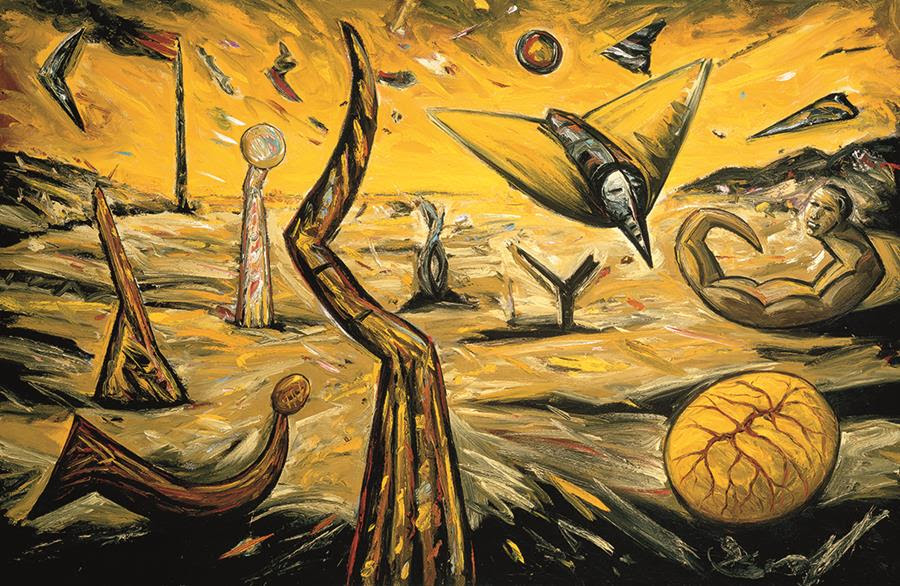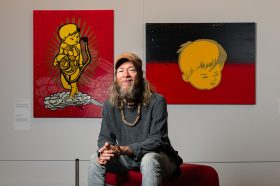It’s been nearly 20 years since the dynamic, powerful paintings of Melbourne-based artist Peter Booth have been shown in a comprehensive solo exhibition. His artwork, from the 1970s to his most recent paintings from 2022, are currently on exhibition at the TarraWarra Museum of Art. Some of the pieces have been brought out of TarraWarra’s collection, while others are on loan from the National Gallery of Victoria (NGV) and private collections. The exhibition closes soon, and is well worth a day trip out to the Yarra Valley.
Booth’s career spans many decades, and his style has evolved throughout the years, affected by his personal experiences and the global and environmental issues surrounding him at the time. Seeing these powerful, arresting paintings and drawings all together is an unforgettable experience. The exhibition not only showcases a world-renowned Australian artist, but it also catalogues his influences, experiences and technical skill and training.
Booth’s exhibition shows his artwork by theme and by era, accompanied by prints from artists who inspired and influenced his work, including William Blake, Francisco Goya and Samuel Palmer. The exhibition also provides insight into the global and personal challenges that are reflected in his work, from his childhood experiences growing up in post-World War II Sheffield, to his Cold War concerns about the effects of nuclear bombs on people and the land, to his more recent concerns about ecological collapse and the poisoning of the earth.
Booth’s style is lush, dynamic and abstract, with repeating motifs and themes, such as the road disappearing into the distance, monstrous humans that take over the canvas, tiny figures lost in blasted landscapes, and apocalyptic scenes of destruction or Hell. His style moves from explosive and apocalyptic through the grotesquerie of humanity to lonely white landscapes covered in snow and rocks. When he paints humans, they’re shown in poses and scenes of fear, terror, loss and grief. Many of his paintings have an unreal quality to them, with few shadows to give substance to trees, rocks and buildings.
Some of the artist’s most recent works were inspired by rainforests in Queensland, and have a lightness to their tone compared to works from previous years. However, they are still quintessentially Booth: twisted forms intertwine, colour is lush and laid thickly on the canvas. There is a distinct absence of humans in these more peaceful and colourful examples of his recent works. Booth’s connection with the natural world emerges throughout, inspired by his fascination with the forms and forces of nature.
Booth’s use of paint, colour, form and texture is evocative when seen up close. Being in the room with the artworks allows us to feel the energy, passion and angst driving Booth in his painting. His childhood was marred by loss, as his two brothers died by suicide, and it’s not hard to see his grief and torment reflected in the lonely, lost characters in his art. At times, his work can be confronting and disturbing, especially the scenes of men fighting or eating each other. Other artworks, especially the snow paintings, require us to be still, to feel the loneliness and pain echoing among the trees.
This is artist who brings himself to the canvas, creating mood and energy with paint that is pushed around in gooey, magnificent layers. Despite the heaviness, the fear, the destroyed lands, there is also playfulness, a wicked humour and an obvious love of nature. Booth’s smaller pieces, including Waterfall 1992 (cat. No. 16) and Fire 1993 (cat. No. 18) are delicious in their texture, liberal use of paint, and sense of movement and light.
Read: Exhibition review: A river that flows both ways, Adelaide Contemporary Experimental
Booth’s artwork demands to be seen; more than that, it demands to be experienced. This chance to witness his vast range and the development in his style will not come around again soon. Let’s hope it’s not another 20 years before his paintings are collected together again to showcase the scope of his imagination.
Peter Booth, Tarrawarra Museum
Curated by Anthony Fitzpatrick
The survey of Peter Booth’s work will be on display until 13 March 2023.





